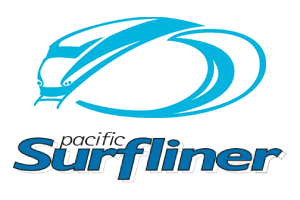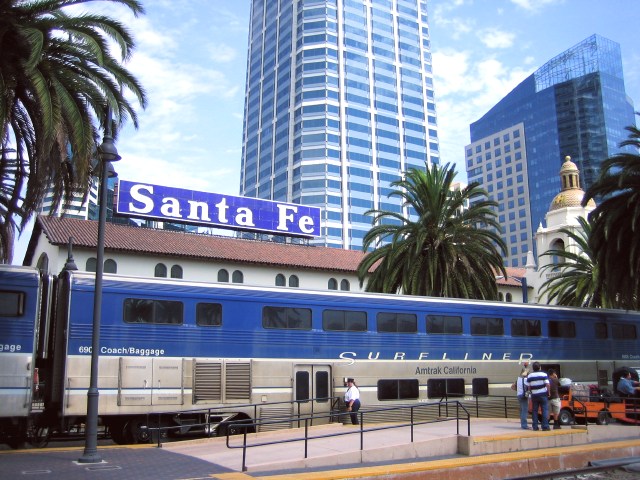- Pacific Surfliner
Infobox rail line
name = "Pacific Surfliner"
color =
logo_width = 200px
image_width = 300px
caption = A "Pacific Surfliner" at the former Santa Fe train depot in San Diego.
type =Inter-city rail
system =Amtrak
status =
locale =
start =San Diego, California
end =San Luis Obispo, California
stations =
routes =
ridership =
open =June 1 ,2000
close =
owner = SDNR, BNSF, SCRRA,San Diego Metropolitan Transit System , UP (track)
operator =Amtrak under contract by Caltrans
character =
stock =
linelength = convert|350|mi|km
tracklength =
notrack =
gauge = RailGauge|ussg
el =
speed =
elevation =
map_state = showThe "Pacific Surfliner" is a 350-mile (563 km)Amtrak passenger train route serving communities on the coast ofSouthern California betweenSan Diego and San Luis Obispo. With 2.7 million passengers in fiscal year 2007, this is Amtrak's most heavily-travelled service outside of theNortheast Corridor . [ [http://www.amtrak.com/pdf/0709monthly.pdf Amtrak Monthly Performance Report September 2007] ] [cite press release| publisher=National Railroad Passenger Corporation| url=http://www.amtrak.com/servlet/ContentServer?pagename=Amtrak/am2Copy/News_Release_Page&c=am2Copy&cid=1093554068300&ssid=181| title=Amtrak Ticket Revenue Tops $1.37 Billion Setting a New Record| date=October 26 2006 | ] , and recovers 59.1% of its operating expenses through ticket sales. [cite web| url=http://www.dot.ca.gov/hq/transprog/ctcbooks/2007/0907/061_3.6.pdf| title=FY 2006-07 4th Quarter Rail Operations Report| author=Bronte, William D.| publisher=State of California Department of Transportation| date=2007-08-15 | format=PDF| ]Route
On the northernmost part there are four trains per day in each direction; on the stretch from Los Angeles to San Diego, a little less than one per hour.
Thruway Motorcoach connections are available between Santa Barbara and Paso Robles during hours when that part of the Coast Line track is in use by freight trains. The route is named after the Santa Fe Railroad's (now owned by Southern California Regional Rail Authority)Surf Line . Over the years, the number of trains and passengers on the route has increased greatly; in the late 1970s there were only three round trips daily between Los Angeles and San Diego.Because neither San Diego, San Luis Obispo, nor Goleta is equipped with a usable wye or a turntable, trains running on the "Pacific Surfliner" are arranged so that the last car (the
cab car ) is one equipped with engineer controls, so that the train can be operated in either direction, allowing for a quick turnaround. This is known as a "Push-pull" configuration. Before the cab cars were used on the line, the trains were wyed in San Diego for their return trip. Los Angeles Union Station is a stub off the mainline which means trains leave Los Angeles facing the opposite direction that they enter. Thelocomotive is at the rear of the train, "pushing" the train from Goleta/San Luis Obispo or San Diego to Los Angeles. At Los Angeles, the train "backs into" the station, and, upon departing the locomotive "pulls" the train to San Diego or Goleta/San Luis Obispo, respectively. Currently a project is being prepared for run-through tracks at Union Station. [cite web| publisher=Federal Railroad Administration| title=Los Angeles Union Station Run-Through Tracks Project| url=http://www.fra.dot.gov/downloads/rrdev/larunexsumm.pdf| format=PDF| accessdate=2007-10-30| ]The entire trip from San Luis Obispo to San Diego is 350 miles (563 kilometers), and takes eight and a half hours. Much of the Pacific Surfliner's scenic route follows the
Pacific coast although trains travel inland through industrial backlots and expansive farmlands to traverse theLos Angeles Basin andSan Fernando Valley . The Pacific Surfliner operates 11 daily trains each way between Los Angeles and San Diego on weekdays and 12 trains each way on weekends.The "Pacific Surfliner" is usually on time; however, the last train south (Train 796) may be held up to one hour if Train 11 (the "
Coast Starlight ") from Seattle is delayed.Fact|date=September 2008Though operated by Amtrak, the "Pacific Surfliner" is primarily financed through funds made available by the State of California Department of Transportation (Caltrans) and is operated under the
Amtrak California brand.Beginning in March 1938, under the
Atchison, Topeka, and Santa Fe Railroad , and later under Amtrak until the late 1990s, this same service was called the "San Diegan ".Rolling stock
"Pacific Surfliner" trainsets usually consist of an
EMD F59PHI locomotive, a business class car, a cafe car with coach seating, two coach cars, and a Cab Control Car equipped with coach seating, a checked baggage space, and engineer controls. During holiday seasons or days of heavy ridership extra cars may be added. As of late, at least one "Superliner" Coach or Coach/Baggage car will often be added to the Surfliner trainsets just before the Surfliner's Cab Car. All but one of the Pacific Surfliner trains consist of double-decker California (II) Cars which are similar to, but not the same as, "Superliner" cars; the remaining train uses four of Amtrak's older single-level Horizon Fleet orAmfleet cars. Amtrak's own page at amtrak.com on this route, as well as its timetables, suggest that all trains use a Surfliner trainset; as a result, passengers occasionally become upset due to the fact that the Horizon Fleet cars lack many of the services typically found on Surfliner Bi level trains. This trainset very occasionally also includes Amtrak's last remaining full-dome car, #10031. Most cars are equipped with 120v power outlets for laptops or other electronic devices. Pacific Surfliner trains use cars whose design is very similar, but not identical, to those on the other Amtrak California trains, theSan Joaquins andCapitol Corridor . The Pacific Surfliner trains are painted in a blue and silver livery that is unique to this line.A typical "Pacific Surfliner" consist is as follows:
*F59PHI (locomotive)
*Pacific Business Class Car
*Coach-Cafe Car
*2-3 Coach Cars
*Coach/Baggage (Cab) CarHowever, during some holiday seasons, the number of cars is increased.In addition, more recently, the strong increase in ridership has led to an increase in the number of trains using six total passenger cars; some trains will have as many as nine. The resulting shortage of Surfliner equipment has forced Amtrak to assemble a second trainset of as many as eight Horizon Fleet and/or
Amfleet cars, in addition to that mentioned above.Timetable and route notes
Amtrak's
Thruway Motorcoach connects passengers from Santa Barbara and San Luis Obispo to Solvang, Buellton, Atascadero and Paso Robles.cite web| url=http://www.amtrak.com/timetable/apr07/W31.pdf| format=PDF| title=Pacific Surfliner timetable| date=2007-04-02 | author=Amtrak| accessdate=2007-06-15]The "Pacific Surfliner" runs southbound as even-numbered trains and northbound with odd numbers.Fact|date=September 2008 Trains with numbers beginning in 5 run only between San Diego and Los Angeles; numbers beginning in 7 are assigned to trains that run north to Goleta or San Luis Obispo (most continuing through Los Angeles to San Diego) and are known as "Central Coast Pacific Surfliners"Fact|date=September 2008. Some 700-series trains have numbers which echo their ancestor's numbers Fact|date=September 2008. For instance, trains 798 and 799 are so numbered in memory of
Southern Pacific Railroad trains 98 and 99, the "Coast Daylight" Fact|date=September 2008 . In the early 2000s the Chatsworth stop initially was only served by a few trips. It proved popular and now all trains that go north of Los Angeles serve it.Fact|date=September 2008Accidents
*On
February 14 ,2005 , a northbound train hit a semi truck that was trapped on the tracks in Oxnard. The impact of the crash caused the locomotive to separate from the six passenger cars it was pulling. No one was killed but two people on board the train were taken to the hospital. Fortunately, neither of them was seriously hurt.Fact|date=September 2008
* OnOctober 23 ,2007 , a northbound train hit a semi truck parked on the tracks in Moorpark. According to the conductor, there were no lights on the truck to alert the crew (it was dark at the time of the accident). No one was hurt and the passengers said the impact of the crash was slight aside from the train braking quickly.Fact|date=September 2008
* OnApril 21 ,2008 , a southbound train struck and killed a male pedestrian who was standing on the tracks in Carlsbad. The crash stopped rail traffic in both directions and passengers were released from the train an hour after the accident.Fact|date=September 2008
* OnJuly 3 ,2008 , a southbound train struck a car that was crossing the tracks in Ventura. There were two people in the car. One was killed and the other injured critically. None of the 196 passengers on board was hurt but the train was stopped at the scene of the crash for hours.Fact|date=September 2008See also
*
San Diego Public Transportation References
External links
* [http://www.amtrak.com/servlet/ContentServer?pagename=Amtrak/am2Route/Vertical_Route_Page&c=am2Route&cid=1081256322013&ssid=132 Amtrak - "Pacific Surfliner"]
* [http://www.dot.ca.gov/rail/go/amtrak/routes/pacific_surfliner/index.cfm Amtrak California--a partnership of Caltrans and Amtrak]
* [http://www.sandag.com/index.asp?committeeid=48&fuseaction=committees.detail LOSSAN Board--composed of local elected officials from the Pacific Surfliner corridor that coordinates planning and programs to increase ridership, revenue, reliability, and safety on the coastal rail line]
* [http://www.amtrak.com/pdf/0601monthly.pdf Amtrak's January 2006 Monthly Performance Report] , which lists the ridership of each Amtrak route on page 26
Wikimedia Foundation. 2010.
